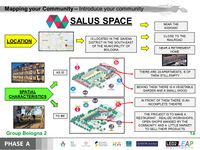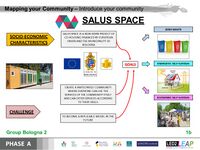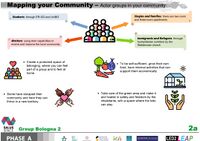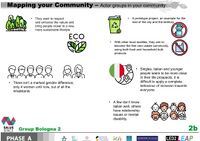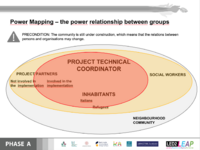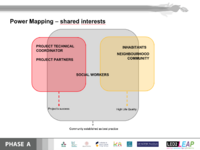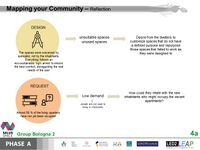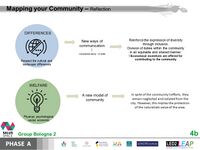LED2LEAP 2021 - Bologna Team 2
>>>back to working groups overview
For help with editing this Wiki page use this link.
For assignments and key readings use this link.
| Area | Salus Space | |
| Place | Bologna | |
| Country | Italy | |
| Topics | Democracy, Landscape projectation, Sustainability, Coworking, Cohousing, Self production | |
| Author(s) | Bianca M., Marco P., Michael V., Stefano T. | |

| ||
Landscape Democracy Rationale
- insert text here
Location and Scope
Salus Space, Bologna
Phase A: Mapping Your Community
Welcome to Your Community and Their Landscape
The community of salus space is located in the Savena district, near the highway, the railroad and close to a retirement home. The complex is not yet the final one, in fact, in addition to the 20 apartments and the vegetable garden, a theater, a restaurant and some small shops will have to be completed. This newly born project of co-housing is funded by the European Union and the municipality of bologna, with the goals of zero waste, energy and economic independece.
Groups of Actors and Stakeholders in Your Community
The main actors are the inhabitants of the area, and this includes 4 types of different groups: students, families and singles, workers, immigrants, and refugees. There are diversified life experiences, age, nationality, actual working place, and past situation.
Other groups of actors, the so-called stakeholders, can be found in a very large scale of intervention; from a European organization to the local scale with the main association that leads the project. There is U.I.A. (Urban Innovative Actions), the Municipality of Bologna, the Waldensian church, ER-GO with the University of Bologna, SAI (System for Acceptance of Immigrants), ATS with Opengroup (Association Temporary of Sake), and last but not least, ETA BETA.
Right now, about half of the apartments are occupied, with an expected total number of inhabitants from 40 to 60 according to the desires and habits of each person in its apartment. 12 accommodations are available by public announcement
Relationships Between Your Actors and Groups
The community of inhabitants is still under construction and today only the 50% of the co-housing apartments are already assigned. In the next months new people will join the co-housing and will be included in the process, which means that the community-map is still un-complete, and other relevant actors may emerge in the future and the relations might change as well.
As described in the pictures, three different relations’ areas between groups have been identified: - Red circle: strong relation - Yellow circle: intermediate relation - Grey circle: weak relation.
The co-housing represents the main output of a European funded project. The consortium has already set the scene, designing the main activities, the monitoring indicators, and the expected outputs. Some of the partners have a stronger role in the project activities, and work on a daily base at Villa Salus. These organisations have the stronger relation with the inhabitants, which are supposed to became the main actors on the field.
Other actors potentially included in the process are the neighbourhood’s inhabitants, which are expected to benefit from the activities and at the same time contribute to develop them.
Summary of Your Learnings from the Transnational Discussion Panel
- The first thing is to identify the need of the community and elaborate the right plan of interviewing the community, according to their possibilities, their behaviours, their identity. Talking to them in their home is a delicate process and has to be managed really carefully and wisely. People that live in an environment for a while, start to process their habits and know exactly what they need and they have to do, even to make internal decisions of complex organization. Our work has to be fulfilling of what they are engaging, and enhance their attitude and feeling of belonging of the space they're living; they already have a network quite autonomous towards the city, that maybe can be upgraded by our knowledge.
Theory Reflection
The definition of spaces is a fundamental part for the good life inside a community. But the architect designed the spaces without the active participation of the inhabitants. Furthermore, a part of these apartments is still uninhabited, probably due to the lack of propaganda and the difficulty of way of life of many people, who are not used to share spaces, stuffs and specially rights and duties.
As the European Landscape Convention said, the diversity of people with different cultural and landscape backgrounds is promoted. In the community differences help to have a complementarity of skills and resources. It tends to become a holistic welfare center, physical, economic, psychological, social. However, the slow mobility routes are not well developed and interconnected, unlike those of fast mobility, but is still inserted in a pleasant and protected surrounding.
References
- Council of Europe, Landscape Convention Contribution to human rights, democracy and sustainable development, 2018
- LED Team (2019):Landscape Education for Democracy (Chapters 1-3, InBo Special Issue)
- Editors Shelley Egoz, Karsten Jørgensen, Deni Ruggeri (2018): Defining Landscape Democracy (introductory chapter)
- https://www.coe.int/en/web/landscape/the-european-landscape-convention
- http://www.saluspace.eu/il-progetto
- https://www.uia-initiative.eu/en/uia-cities/bologna S.A.L.U.S. ‘W’ SPACE
- https://www.etabeta.coop/
Phase B: Democratic Landscape Analysis and Assessment
Marco Palma and Aurora Mihatov Correspondence
Stefano Tagliatti and Paola Modric Correspondence
- ''insert text here''
Michael Venturelli, Yana Babakova, Wiktoria Kiedrowicz and Moussa Ouarhim Correspondence
Delete the boundaries! Be free and be yourself in your environment!
Your Name and Partner's Name Correspondence
- ''insert text here''
Phase C: Collaborative Visioning and Goal Setting
The Scene in Your Story of Visioning
- insert text here
The Actors in Your Story of Visioning
- insert text here
The Story of Visioning
- insert text here
Reflect on Your Story of Visioning
- insert text here
Phase D: Collaborative Design, Transformation and Planning
Your Prototyping Action
- insert text here
The Evolution of Your Prototyping Action
- insert text here
The Plan Behind Your Prototyping Action
- insert text here
The Realization of Your Prototyping Action
- insert text here
Reflect on Your Prototyping Action
- insert text here
Phase E: Collaborative Evaluation and Future Agendas
Collaborative Evaluation and Landscape Democracy Reflection
- insert text here
The Actors in your Collaborative Evaluation
- insert text here
Reflection on the Online Seminar
- insert text here
Reflection on the Living Lab Process
- insert text here
Your Living Lab Code of Conduct
- insert text here
Process Reflection
- insert text here
